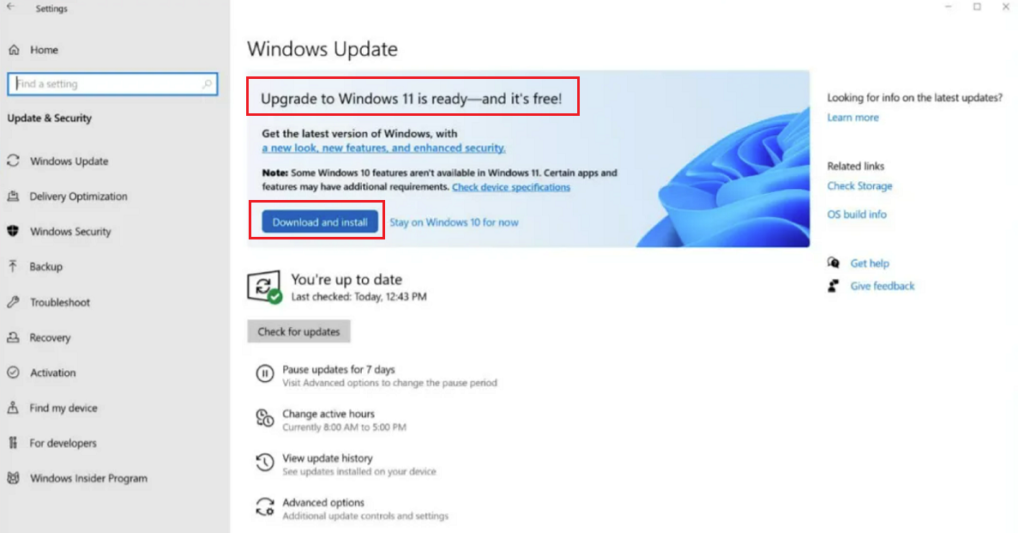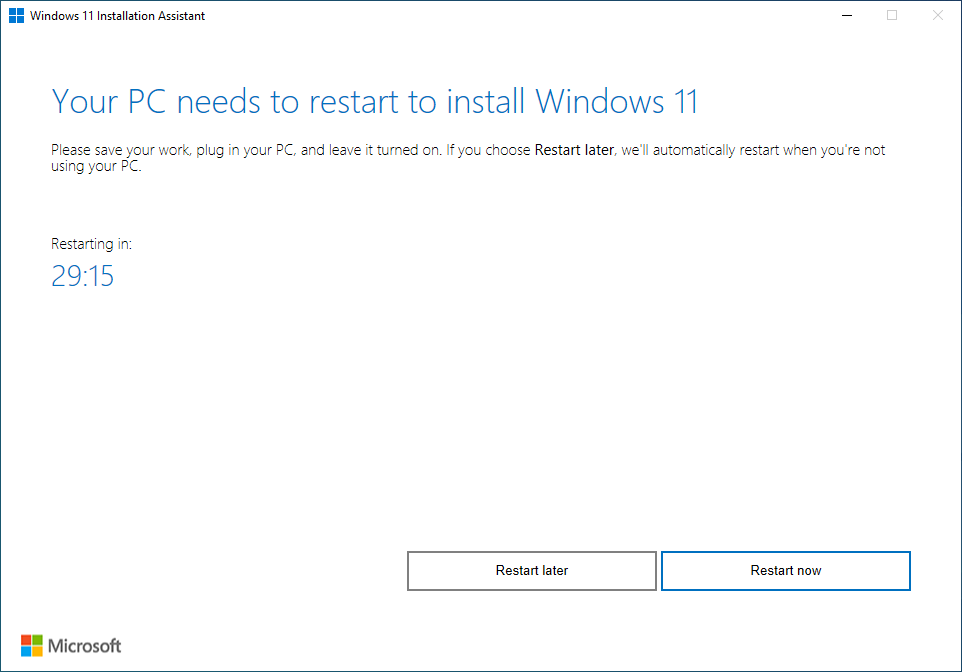How to Upgrade to Windows 11 Securely?
A clear step by step guide to upgrade to Windows 11 from any Windows 10 PC. You can get the free upgrade even if Windows Update doesn’t offer it or even if your computer is not officially supported, you can still upgrade to Windows 11 and just remember that Microsoft warns you may experience problems and won’t guarantee future updates for Windows on your hardware.
Upgrade to Windows 11 Securely
There are 3 options below to upgrade to Windows 11. The first one, upgrade to Windows 11 using Windows update, the second one is upgrading to Windows 11 using Windows 11 Installation Assistant and the third one is to perform a reinstall or clean install of Windows 11 on a new or used PC. Check out each one to determine the best option for you.
If you are upgrading from Windows 10, Microsoft recommends that you wait until you are notified through Windows Update that the upgrade is ready for your computer, but the second method using Windows 11 Installation Assistant is also safe and secure to upgrade Windows 10 to Windows 11 without losing data.

Let’s check your computer if you are eligible for upgrading through Windows Update. If not, just go ahead and upgrade using Windows 11 Installation Assistant.
- Press Windows key on your computer.
- Type “Windows update” to open up Windows update Settings window.
- Click the “Check for updates” button to see if any updates are available. If your PC is ready for Windows 11, you’ll see the “Upgrade to Windows 11 is ready—and it’s free!” banner.
- If the upgrade to Windows 11 is ready, then click the Download and install button to go ahead and complete the upgrade to Windows 11 process.
Note: If you don’t see the upgrade to Windows 11 is ready banner, it doesn’t mean that your PC is not compatible with an upgrade. Because Microsoft will slowly be offering this update to more and more PCs over time. If you don’t like to wait for Microsoft, you can use the Windows 11 Installation Assistant method to upgrade to Windows 11.
Before installing, please refer to the PC Health Check app to confirm your device meets the minimum system requirements for Windows 11 and check the Windows release information status for known issues that may affect your device.
Upgrade using Windows 11 Installation Assistant
This is the best option for installing Windows 11 on the device you’re currently using. Download the Windows 11 Installation Assistant and get start upgrading now. The Windows 11 Installation assistant is for those who wish to Upgrade a Windows 10 PC to Windows 11 right now.
Before you begin, check to see if the following conditions apply to you:
- Your PC must have Windows 10, version 2004 or higher installed to run Installation Assistant.
- Your PC meets the Windows 11 device specifications for upgrade requirements and supported features. Certain features require additional hardware. We also recommend that you visit your PC’s manufacturer’s website for information about updated drivers and hardware compatibility.
- Your PC must have 9 GB of free disk space to download Windows 11.
Download and Install Windows 11 Installation Assistant:
- Download from here Installation Assistant and run it as administrator and follow up the instructions.
- Once the tool confirms the device hardware is compatible, you will be presented with the license terms. Select Accept and Install.
- Once the Installation Assistant has completed the 3 stages and is ready, click the Restart Now button to complete installation on your computer.
- It might take some time to install Windows 11, and your PC will restart a few times
Note: Make sure you don’t turn off your computer during upgrade process. The stage 1 of 3 is a bit time consuming if your internet connection is slow, but it’s fine to keep using your computer while it downloading.

Step 3 of 3: Installing will take a bit shorter time. It depends on your computer hardware performance to complete it faster or slower.
Finally, when it has been completed, you can click the Restart now button to restart your PC and complete the Windows 11 upgrading process.

If the system asks you “You’re about to be signed out. Windows 11 installation Assistant will reboot your device to complete the installation” click Close to reboot it.
Note: If you are using a Laptop, make sure your laptop is power plugged in while finalizing the upgrade. Your computer will be restarted several times.
After completing all tasks, you must face a Welcome to Windows 11 like the below screenshot. This is also a perfect way of upgrading Windows 11 from Windows 10 PCs without losing data.
Done! You’ve completed successfully the Windows 10 to Windows 11 upgrade using Windows 11 Assistant method. Good luck with Windows 11 upgrade on your PC.
If you need a clean Windows 11 installation on a different PC or an ARM64 device, you have to create a Windows 11 installation media using the below guide.
Upgrade using Windows 11 Clean Installation
Create a Windows 11 Installation Media if you want to perform a reinstall or clean install of Windows 11 on a new or used PC, use this option to download the media creation tool to make a bootable USB or DVD. To get started you first need a license to install Windows 11 or have a Windows 10 device that qualifies for an upgrade to Windows 11.
Note: If you don’t have a Windows 11 license you can Download Windows 11 enterprise and use it free for 6 months. After that, you can reinstall or buying a license.
Make sure you have:
- Sufficient data storage available on the computer, USB, or external drive you download Windows 11 iso file.
- A blank USB or blank DVD. Best options is using USB drive. The content on it will be deleted during installation. Make sure you don’t have important contend on your USB.
Ensure the PC you want to install Windows 11:
- Has a 64-bit CPU: Windows 11 can only run on 64-bit CPUs. To see if your PC has one, go to Settings > System > About, or search “System Information” in Windows and look under “System Type.”
- Meets system requirements: Not all devices running Windows 10 are eligible to receive a Windows 11 upgrade. See the Windows 11 device specifications for upgrade requirements and supported features. Certain features require additional hardware. We also recommend that you visit your PC’s manufacturer website for information about updated drivers and hardware compatibility.
- WARNING: Installing Windows 11 media on a PC that does not meet the Windows 11 minimum system requirements is not recommended and may result in compatibility issues. If you proceed with installing Windows 11 on a PC that does not meet the requirements, that PC will no longer be supported and won’t be entitled to receive updates. Damages to the PC due to lack of compatibility aren’t covered under the manufacturer warranty.
- Matches your current language: You’ll need to choose the same language when you install Windows 11. To see what language you’re currently using, go to Time & language in PC settings or Region in Control Panel.
Using the Media Creation Tool to create installation media:
- Download media creation tool and run it as administrator to create a Windows 11 bootable USB. Or read this article to Make a Windows 11 bootable USB using diskpart command line utility.
- If you agree to the license terms, select Accept.
- On the What do you want to do? page, select Create installation media for another PC, and then select Next.
- Select the language, edition, and architecture (64-bit) for Windows 11.
- Select which media you want to use:
- USB flash drive: Attach a blank USB flash drive with at least 8GB of space. Any content on the flash drive will be deleted.
- ISO file: Save an ISO file to your PC. This can be used to create a bootable DVD. After the file is downloaded, you can go to location where the file is saved, or select Open DVD burner, and follow the instructions to burn the file to a DVD.
After the installation media is created, follow the steps below to use it.
- To check for updates now, select the Start button, and then go to Settings > Windows Update, and select Check for updates. You may also wish to visit your device manufacturer’s support site for any additional drivers that may be needed.
- Note: Drivers for Surface devices may be found on the Download drivers and firmware for Surface page.
Important Note: Before you install Windows 11, it’s a good idea to save any work and back up your PC before you start. If you used the Media Creation Tool to download an ISO file for Windows 11, remember to burn it to a DVD before following these steps:
- Attach the USB flash drive or insert the DVD on the PC where you want to install Windows 11.
- Restart your PC.
- If your PC does not automatically boot to the USB or DVD media, you might have to open a boot menu or change the boot order in your PC’s BIOS or UEFI settings.
- To open a boot menu or change the boot order, you’ll typically need to press a key (such as F2, F12, Delete, or Esc) immediately after you turn on your PC. For instructions on accessing the boot menu or changing the boot order for your PC, check the documentation that came with your PC or go to the manufacturer’s website.
- If you do not see the USB or DVD media device listed within the boot options, you may need to reach out to the PC manufacturer for instructions for temporarily disabling Secure Boot in your BIOS settings.
- If changing the boot menu or order doesn’t work, and your PC immediately boots into the OS you want to replace, it is possible the PC had not fully shut down. To ensure the PC fully shuts down, select the power button on the sign-in screen or on the Start menu and select Shut down.
- On the Install Windows page, select your language, time, and keyboard preferences, and then select Next.
- Select Install Windows.
- Go ahead and complete the Windows 11 installation like Windows 10 installation.
Done!
Please share your Windows 11 upgrade and installation issue through the comment section. We will try to help you resolve the issue faster.

Thanks for clean description. My Laptop is new and I’ve upgraded successfully with Windows 11 installation assistant. Concern about my old desktop, if I can fresh install it.